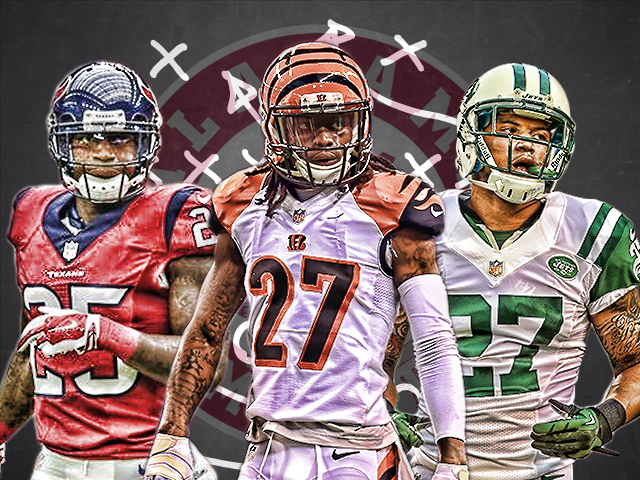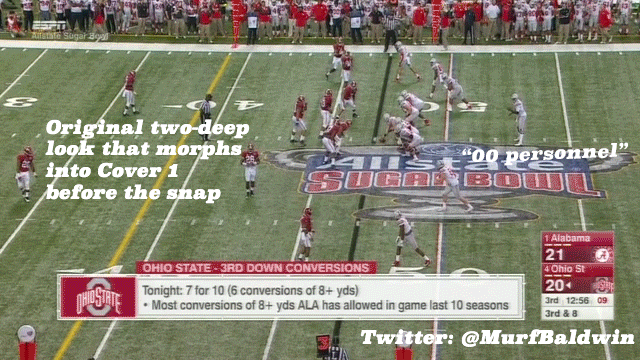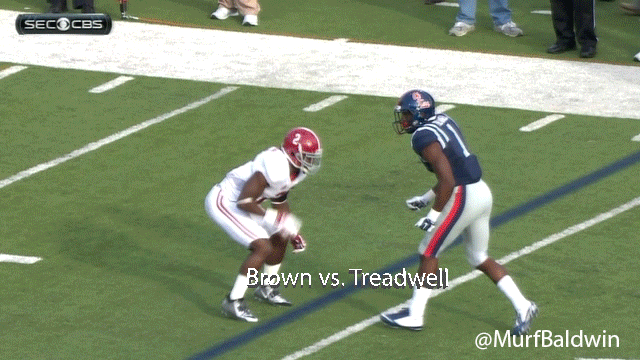Film Study: Examining if Alabama truly has NFL talent at cornerback
After the University of Alabama’s recent struggles in the secondary against the likes of Texas A&M University, the University of Oklahoma and Auburn University, among others, many wondered if the cornerback position — which had once been a calling-card for head coach Nick Saban’s defensive scheme — would once again reclaim its position amongst the elite of the elite.
Despite the fact that the Tide corners received the benefit of virtually always playing with the lead, and it had a formidable front seven that squeezed the juice out of the run game, the talented unit continued to struggle and most certainly assisted in the disappointing finish to the Tide’s College Football Playoff run.
Now some are questioning if Alabama truly has the talent to compete with the high-powered offenses that are beginning to litter its schedule.
When your coach is the premier defensive backs coach in all of football, you have to figure the futility can’t continue for much longer.
Alabama is stacked with 4- and 5-star talent, it’s only a matter of time before receiving targets are back getting locked down like they were at the beginning of Saban’s tenure.
I think…
Talent Discrepancy?
For as far back as I could remember, Coach Saban has been the authority on all things defensive backs dating back to his time spent as the DB coach/defensive coordinator at Michigan State University in the late 1980’s.
By the time he landed in the SEC with Louisiana State, from 2000-04, he had already gone through the rigors of both the NFL and collegiate football. However, it was his time spent under famed coach Bill Belichick (New England Patriots) that shaped a great deal of the schematic approach we see now.
Saban favored lengthy corners who excelled in off- and press-man coverage and had legit tackling ability in open space.
The 6’0″, 202-pound Corey Webster most exemplified that theory in helping guide the Tigers to the 2003 BCS National Championship behind his uber-physical play at the CB position — parlaying that into a second-round selection in the ’05 draft.
By the time Saban arrived in Tuscaloosa he made sure to recruit future first-round pick Kareem Jackson, a 5’10”, 188-pound corner who was equally adept in man- or zone-based principles.
Additionally, Jackson’s tenure coincided with my personal favorite of the Saban era, former 2012 first-round pick Dre Kirkpatrick.
The 6’2″, 190-pound Kirkpatrick was by far the most physical CB I’ve ever seen. In fact, I’ve always wondered why he wasn’t used at free safety where his bone-jarring tackling ability would serve as an equal reinforcement with then-safety Mark Barron, coincidentally, the seventh-overall pick in the 2012 draft.
However, Kirkpatrick was a nuisance to receivers at the line of scrimmage where he specialized in bump-and-run coverage which undoubtedly helped to cement Bama’s pass rush.
To further drive home the point, Kirkpatrick combined with the 6’0″, 201-pound Dee Milliner — a former ninth-overall pick on the New York Jets — to form the most complete duo of the Saban era. It’s not a coincidence that many consider the 2011 Alabama defense one of the best ever.
Any corners lining up in Saban’s 3-4-based, multiplicative defense will be measured against the exploits of that 2011 duo. Does Bama have the talent on the roster to actually form that type of a tandem?
Let’s check it out.
Eddie Jackson
The 6’0″, 188-pound Eddie Jackson was billed as the very best corner on Bama’s roster in part because of how he performed in a limited capacity during the 2013-14 season when the Tide didn’t possess an NFL-caliber corner.
Yeah, I know it’s hard to believe, but John Fulton and Deion Belue were the least effective pair of starters of the era and it wasn’t a surprise that neither were drafted.
So when Jackson came in to help out when receivers were torching the Tide secondary, and actually made plays on the ball, he was instantly billed as being more like his predecessors opposed to his current peers.
That type of analysis proved to be premature as he looked exactly like Fulton and Belue last season as a full-time starter. In fact, he seemed to possess a lot of the same traits: a lack of understanding of route concepts, the inability to locate the ball in flight and a lack of makeup speed.
Case in point, although Jackson was supposed to have help over the top against this 9-route, he failed to get a hand on the receiver at the bottom of the route, thus making it a footrace. And even though the pass was underthrown, Jackson was unable to make a difference as he had gotten stacked and would’ve had to interfere with the receiver to stop him.
Hopefully Jackson’s woes were due to the knee injury he sustained last spring. If not, he may find himself in the same boat as Fulton and Belue. (Jackson also must clean up his open-field tackling ability.)
Brad Sylve
Rising senior Brad Sylve was the early-season whippin’ stick for Tide fans as he literally looked like Belue had snuck back on campus and changed jersey numbers from No. 13 to No. 3.
In retrospect, well not if you’ve followed my work all year, his destruction by West Virginia’s Kevin White in the Chick-fil-a Kickoff Classic wasn’t anything to be ashamed of…nah, I’m lying; as great of a receiver as White turned out to be (a surefire top-15 pick), it’s hard to imagine Kirkpatrick or Milliner being completely destroyed like that.
White undoubtedly has the skill set of former Tide great Julio Jones, however, a better corner may have had a more efficient showing against the future first-round pick.
Check out how White did Sylve on this 9-route: Sylve was stacked as he didn’t trust his ability to be in the right place and tried to “chicken fight” with a much more physical receiver.
But as fast as White is, 4.35 40-yard dash speed, Sylve was every bit his equal. Where the latter faulted at was with his inability to actually track the ball; face guarding will get you beat nine out of 10 times.
Sylve ended up collecting splinters in his butt the rest of the season until he resurfaced for a respectable showing when Auburn was lighting Bama up through the air in last season’s Iron Bowl.
I won’t totally write Sylve off, however, I don’t believe he’s an NFL-caliber talent as he lacks the necessary instincts for the position. But he has a shot to right his wrongs as he’s undoubtedly gifted physically.
Cyrus Jones
Fans may not want to hear this, as Cyrus Jones contributed to the 2013 debacle in the secondary, but No. 5 was the best corner on the squad. At 5’10”, 194 pounds, Jones showed the ability to shadow receivers and was a lot more physical than given credit for.
And while he was far from perfect, you have to believe he has the upper hand to play the right corner spot.
In what turned out to be one of his team-leading three interceptions (tied with departed safety Landon Collins), Jones showed of his phenomenal speed in stacking Tennessee Vols’ receiver Marquez North on this 9-route, thus running the route for the receiver.
He also showed off his great hands by making an over-the-shoulder grab even with Collins unleashing a little bit of friendly fire.
In addition to the three picks, Jones contributed 13 pass-deflections effectively showing off his improved man coverage skills.
Jones’ confidence should be at an all-time high which is half the battle as a defensive back. Jones has a ton of room to improve, but he also has a ton of tools in his belt.
However, he’s a mid- to late-round talent, in my honest assessment.
Tony Brown
5-star freshman Tony Brown arrived at the Capstone with a ton of hype. At, 6’0″, 198 pounds, running a reported 4.35 40-yard dash, there was very little question of if Brown could match up physically in conference stacked with future professional stars.
But as I always say: This ain’t the Olympics, homie.
Football is about having confidence in what you’re’ doing and having the wherewithal to execute in the nuances of your position.
And it goes to show you how much of a jump college is from the prep ranks as Brown didn’t have the type of success many predicted (including yours truly). In fact, it’s safe to say Brown didn’t have any success.
Here we see Brown getting schooled by another potential first-round pick, University of Mississippi receiver Laquon Treadwell (6’2″, 230 lbs).
On this quick hitch, Brown failed to get the jam, which is a no-no against a powerful receiver like that, and paid for it in the form of a touchdown.
Although his first season on campus was one big learning experience, Brown has early-round potential as it stands now; expect him to take a big leap in his second season as Saban drives home the need for him to concentrate on the little things that make a great corner.
The Freshmen
The most talented corner on the roster may have been 5-star recruit Marlon Humphrey — who, like Brown, has track speed, and he has ideal height at 6’1″. The great Wes Neighbors divulged to me during a radio spot on 97.7 The Zone’s Talkin’ Ball with Drew DeArmond that Humphrey “needed to get stronger physically,” which was part of the reason Saban chose to redshirt him.
If Humphrey has gained the necessary strength for the position, he could be a budding star as he has some of the most consistent technique I’ve seen in any young corner not named Vernon Hargreaves III.
Alabama has added another couple of highly touted recruits in Minkah Fitzpatrick (6’1″, 198 lbs) and Kendall Sheffield (6’0″, 181 lbs). Sheffield seems to be receiving more of the hype, but I really like what I see from Fitzpatrick.
Although most of the corners for Alabama were highly recruited — and are coached as well as you’ll ever see — it’s hard to project most of the corps to an NFL roster. And it’s really hard to say if anybody on the roster can put it all together like Milliner, Kirkpatrick or Jackson.
But let’s be honest; the Tide will return, perhaps, the preeminent front seven in college football, which should aid the secondary immensely.





